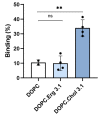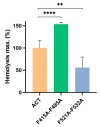Four Cholesterol-Recognition Motifs in the Pore-Forming and Translocation Domains of Adenylate Cyclase Toxin Are Essential for Invasion of Eukaryotic Cells and Lysis of Erythrocytes
- PMID: 35955837
- PMCID: PMC9369406
- DOI: 10.3390/ijms23158703
Four Cholesterol-Recognition Motifs in the Pore-Forming and Translocation Domains of Adenylate Cyclase Toxin Are Essential for Invasion of Eukaryotic Cells and Lysis of Erythrocytes
Abstract
Adenylate Cyclase Toxin (ACT or CyaA) is one of the important virulence factors secreted by Bordetella pertussis, the bacterium causative of whooping cough. ACT debilitates host defenses by production of unregulated levels of cAMP into the cell cytosol upon delivery of its N-terminal domain with adenylate cyclase activity (AC domain) and by forming pores in the plasma membrane of macrophages. Binding of soluble toxin monomers to the plasma membrane of target cells and conversion into membrane-integrated proteins are the first and last step for these toxin activities; however, the molecular determinants in the protein or the target membrane that govern this conversion to an active toxin form are fully unknown. It was previously reported that cytotoxic and cytolytic activities of ACT depend on membrane cholesterol. Here we show that ACT specifically interacts with membrane cholesterol, and find in two membrane-interacting ACT domains, four cholesterol-binding motifs that are essential for AC domain translocation and lytic activities. We hypothesize that direct ACT interaction with membrane cholesterol through those four cholesterol-binding motifs drives insertion and stabilizes the transmembrane topology of several helical elements that ultimately build the ACT structure for AC delivery and pore-formation, thereby explaining the cholesterol-dependence of the ACT activities. The requirement for lipid-mediated stabilization of transmembrane helices appears to be a unifying mechanism to modulate toxicity in pore-forming toxins.
Keywords: RTX toxins; bacterial toxins; lipid-protein interactions; pore-forming toxins.
Conflict of interest statement
The authors declare that they have no conflict of interest with contents of this article. The funding sources had no involvement in the study design nor in the collection, analysis, and interpretation of data nor in the writing of the report or in the decision to submit the article for publication.
Figures












Similar articles
-
Cholesterol stimulates the lytic activity of Adenylate Cyclase Toxin on lipid membranes by promoting toxin oligomerization and formation of pores with a greater effective size.FEBS J. 2021 Dec;288(23):6795-6814. doi: 10.1111/febs.16107. Epub 2021 Jul 14. FEBS J. 2021. PMID: 34216517 Free PMC article.
-
Phospholipase A activity of adenylate cyclase toxin mediates translocation of its adenylate cyclase domain.Proc Natl Acad Sci U S A. 2017 Aug 15;114(33):E6784-E6793. doi: 10.1073/pnas.1701783114. Epub 2017 Jul 31. Proc Natl Acad Sci U S A. 2017. PMID: 28760979 Free PMC article.
-
Selective Enhancement of the Cell-Permeabilizing Activity of Adenylate Cyclase Toxin Does Not Increase Virulence of Bordetella pertussis.Int J Mol Sci. 2021 Oct 28;22(21):11655. doi: 10.3390/ijms222111655. Int J Mol Sci. 2021. PMID: 34769101 Free PMC article.
-
Bordetella adenylate cyclase toxin: a unique combination of a pore-forming moiety with a cell-invading adenylate cyclase enzyme.Pathog Dis. 2015 Nov;73(8):ftv075. doi: 10.1093/femspd/ftv075. Epub 2015 Sep 20. Pathog Dis. 2015. PMID: 26391732 Free PMC article. Review.
-
Membrane Activity and Channel Formation of the Adenylate Cyclase Toxin (CyaA) of Bordetella pertussis in Lipid Bilayer Membranes.Toxins (Basel). 2020 Mar 10;12(3):169. doi: 10.3390/toxins12030169. Toxins (Basel). 2020. PMID: 32164365 Free PMC article. Review.
Cited by
-
Membrane Interaction Characteristics of the RTX Toxins and the Cholesterol-Dependence of Their Cytolytic/Cytotoxic Activity.Int J Mol Sci. 2024 Mar 8;25(6):3131. doi: 10.3390/ijms25063131. Int J Mol Sci. 2024. PMID: 38542105 Free PMC article. Review.
-
Toxin-triggered liposomes for the controlled release of antibiotics to treat infections associated with the gram-negative bacterium, Aggregatibacter actinomycetemcomitans.Colloids Surf B Biointerfaces. 2024 Jun;238:113870. doi: 10.1016/j.colsurfb.2024.113870. Epub 2024 Mar 21. Colloids Surf B Biointerfaces. 2024. PMID: 38555763 Free PMC article.
References
MeSH terms
Substances
Grants and funding
LinkOut - more resources
Full Text Sources

